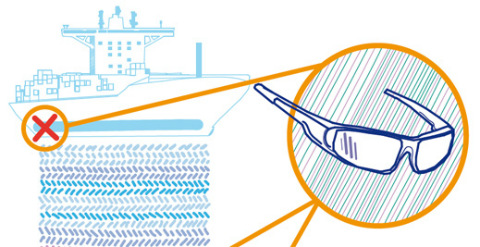Augmented reality
Augmented reality is reflected into the glasses and you are able to see constructions, walls and elements, which are not yet built. Science fiction? Maybe not for long.

The Business and Innovation Development (BID) unit of the University of Turku has launched an interesting MARIN project, which develops augmented reality (AR) to help the marine industry. The goal is to transfer the ship’s blueprints from an ordinary mobile phone into the builder’s glasses. The glasses are see-through but they add elements to the environment. Therefore it is possible to work while wearing the glasses.
Products which reflect augmented reality to glasses or to a car’s windshield are already on the market. What makes the BID’s project exceptional is that even when not connected to a network, the mobile phone knows in which part of the ship the builder is or to which direction is she looking. Through the glasses the builder can see precisely where the lead-throughs should be drilled.
Effectiveness and easiness
The project is led by Senior Researcher, PhD Teijo Lehtonen from the University of Turku. The project was started because of a clear demand on the marine industry’s side. Last winter Lehtonen participated in marine and ICT branches’ shared innovation forum in which the project kicked off.
- I remember that one shipbuilding supervisor told what’s it like when you go to the shipyard and it’s cold and dark and it rains. You take out the ship’s blueprints, try to make sense of them and compare them to the actual hull structure and try to piece together what to do and where to start and which part is which, Lehtonen recalls.
- Anyone who has ever drilled a hole to the middle of a wall knows that you tend to want to measure the place twice or thrice. It takes 5–10 minutes, so it’s not a big deal. However, in a ship you might make thousands of holes and if you get five minutes savings on each, it has a big financial impact.
- These are the type of things we concentrate on in product development, things that help and make the shipbuilders’ work more effective, Lehtonen summs.
View after the renovation
Could the project benefit other areas than shipyards? At home the system could be for example utilized for securing shelves on the walls. Before drilling you need to know, if there are wires or outriggers behind the wall. You could reflect the right places for the shelf fasteners on the glasses.
- In this project we have mainly used line graphics. When the basic technical structure is solid enough, more complex pictures become available as well. In future, augmented reality might look very good.
- One possible application target could be renovation. You could go inside the renovated building with the glasses on and see how the place will look after the renovations are done. There could be several architectural plans downloaded in the mobile phone and you could switch them on the fly, envisages Lehtonen.
The MARIN project’s partner companies are Nokia, STX Finland, Cadmatic, Premode, Kovilta, BA Group, Lloyd’s Register, Nextfour Group, Wallius Welding Machines, Microsoft, Yrityssalo and Machine Technology Center Turku. The project is funded by Tekes.
Text: Hannu Aaltonen and Henna Borisoff
Pictures: Maarit Kotiranta